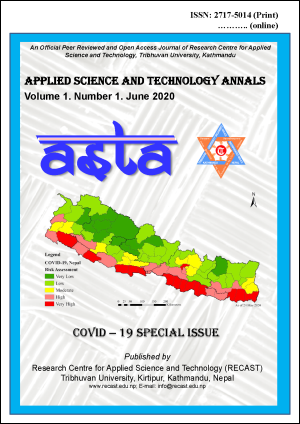Geospatial mapping of COVID-19 cases, risk and agriculture hotspots in decision-making of lockdown relaxation in Nepal
DOI:
https://doi.org/10.3126/asta.v1i1.30263Keywords:
COVID-19, GIS, risk analysis, agriculture, lockdown relaxation, agroeconomyAbstract
The study has explored the risk scenario via geospatial mapping of temporal transmission trend of COVID-19 in 77 districts of Nepal focusing on the district-wise risk analyses based on present active cases, population density and land entry points from neighboring countries. In overall, low to very high risk zones have been identified. Jhapa, Morang and Sunsari districts of Province 1; Dhanusa, Mahottari, Sarlahi, Rautahat, Bara and Parsa districts of Province 2; Kathmandu district of Bagmati Province, Nawalparasi West, Rupandehi, Kapilbastu and Banke districts of Province 5, as well as Kailali of Sudurpanchim Province are identified to have very high risk for COVID-19 spread. The rapid growth in the number of cases has made many districts remarkably susceptible to the infection. The vulnerability analysis has been then followed by identification of agriculture hotspots across the country in terms of major crops. 42 districts with moderate to high crop productivities have been recognized as being not in very high risk zones where the government should allow farmers to do their agriculture activities with well-maintained social distance and other safety precautions. The results when combined would suggest an urgent decision by the Government for gradual lockdown relaxation for agro-economic reinstatement what is commonly called the latent comparative advantage for Nepalese economy after tourism.
Downloads
Downloads
Published
How to Cite
Issue
Section
License
© Research Centre for Applied Science and Technology (RECAST)

